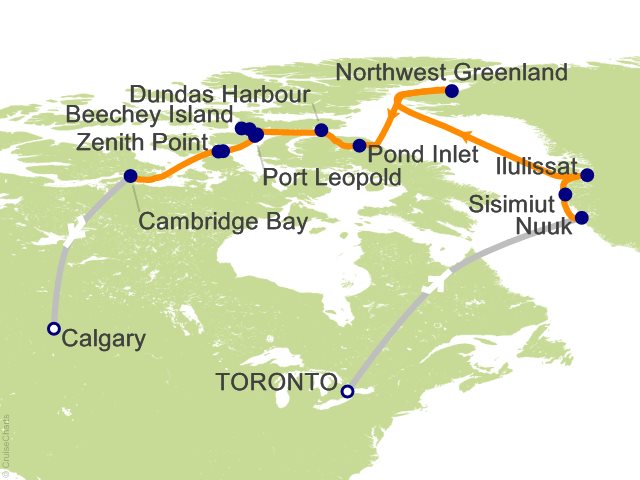In genuine expeditionary style, our itinerary for the following days is heavily dependent on weather conditions and unpredictable sea ice. The following places are some that we hope to visit. Devon Island (Tallurutit): At a latitude of almost 75 degrees north, we are now truly in the High Arctic. Here, nutrient-rich waters support an abundance of wildlife, giving the area the moniker 'wildlife superhighway' of the Arctic. Devon Island (Tallurutit) is the largest uninhabited island on Earth and features stunning geology, with flat-topped mountains and glacial valleys giving Devon Island its unique character. We hope to visit Dundas Harbour to enjoy offers walks on undulating tundra, and perhaps some birdwatching. A dilapidated Royal Canadian Mounted Police outpost and remnants of a Hudson's Bay Company trading post can be found here. In the bay, walruses are often present. Other possible places that we might visit include Croker Bay and Maxwell Bay. Beechey Island: At the western end of Devon Island lies Beechey Island, where we plan to land. Named after Frederick William Beechey, the island is a designated Canadian National Historic Site. During the Franklin expedition of 1845-46, Franklin attempted to sail through the Northwest Passage with HMS Erebus and HMS Terror, with perilous results - three of his men are buried here. Roald Amundsen landed at Beechey Island in 1903, during the first successful voyage by ship to fully transit the Northwest Passage from the Atlantic Ocean to the Pacific Ocean. Radstock Bay: Just a short distance away, Radstock Bay offers a captivating contrast to the open sea. Here, we'll disembark via Zodiac onto a beach strewn with remnants of the past. Explore the ruins of a Thule village nestled beneath the imposing Caswell Tower, where well preserved stone dwellings coexist with artifacts from later explorers. Witness the stark beauty of this remote bay, characterized by its dramatic cliffs, gravelly beaches, and the scattered remains of whale skeletons that have shaped the landscape and the lives of those who called it home. Prince Leopold Island (Appait): On the southern side of Lancaster Sound from Beechey Island lie the towering bird cliffs of Prince Leopold Island (Appait), a historic site where in 1848, English explorer James Clark Ross overwintered during the search for the missing Franklin expedition. Prince Leopold Island is the most important bird sanctuary in the Canadian Arctic, with approximately 500,000 birds nesting here in summer. Ringed seals are often spotted on the sea ice around the island and polar bears often lurk nearby. Port Leopold: Port Leopold, a barren, windswept bay on the northeastern corner of Somerset Island (Inuktitut Kuuganajuk), is steeped in history. Here, the crews of HMS Enterprise and Investigator were forced to endure a harsh winter while searching for the lost Franklin expedition. Their presence is indelibly marked on a rock engraved with "1849" and the ships' initials. The desolate landscape is punctuated by a lone Hudson Bay Company hut, a failed trading post from the 1920s. We hope to hike and explore the coastline, discovering the historic Hudson Bay Company house and intriguing Inuit archaeological sites. Be amazed by the otherworldly formations shaped by the region's freezing and thawing cycles, which our expedition team will detail during recap. Nearby, a cairn marks the spot where Ross's rescue expedition left vital supplies. Bellot Strait: A deep and windy waterway bordered by steep slopes, Bellot Strait is characterized by strong, swirling, tidal currents that require navigation to be undertaken close to times of slack water (four times a day). Note: Due to swirling currents up to 10 knots, Bellot Strait is better transited during eastbound voyages because if it is blocked, there is the alternative to continue north through Peel Sound. On a westbound voyage, it would be necessary to make a long detour back north through Prince Regent Inlet. Hazard Inlet: We hope to visit an Inuit site inhabited by bowhead whale hunters during the 15th and 16th centuries. The remains of over 100 bowheads are scattered across the village and beach, a testament to the community's reliance on this marine giant. Excavations have uncovered around 20 sod houses, though evidence suggests there may have been as many as 40. The cliff face behind the site holds community burial grounds, while caches, kayak, and umiak stands line the shore. This remarkable site offers a poignant glimpse into the lives of these Inuit families, who worked cooperatively to hunt bowhead whales for sustenance and building materials. It's an extraordinary privilege to experience this piece of history firsthand. Zenith Point: Zenith Point, a rocky promontory jutting into the ocean, offers breathtaking panoramic views. As you step ashore, you'll feel a profound sense of isolation and wonder. This is a place where time seems to stand still, and the only sounds are the wind and the crunch beneath your boots. ...
Read More








